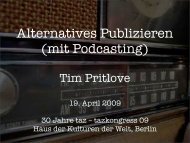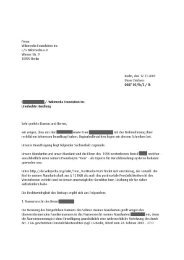Proceedings
Proceedings
Proceedings
You also want an ePaper? Increase the reach of your titles
YUMPU automatically turns print PDFs into web optimized ePapers that Google loves.
| 126<br />
Abstract<br />
Developing Intelligent Search Engines<br />
Developers of search engines today do not only<br />
face technical problems such as designing an efficient<br />
crawler or distributing search requests among<br />
servers. Search has become a problem of identifying<br />
reliable information in an adversarial environment.<br />
Since the web is used for purposes as diverse<br />
as trade, communication, and advertisement<br />
search engines need to be able to distinguish different<br />
types of web pages. In this paper we describe<br />
some common properties of the WWW and social<br />
networks. We show one possibility of exploiting<br />
these properties for classifying web pages.<br />
1 Introduction<br />
Since more and more data is made available online,<br />
users have to search an ever growing amount<br />
of web pages to find the information they seek. In<br />
the last decade search engines have become an important<br />
tool to find valuable web sites for a given<br />
query. First search engines did rely on simply computing<br />
the similarity of query and page content to<br />
find the most relevant sites. Today, most engines<br />
incorporate some external relevance meassure, like<br />
the page rank [23], to determine the correct ranking<br />
of web pages. Intuitively, each web page gets<br />
some initial “page rank”, collects additional weight<br />
via its inlinks and evenly distributes the gathered<br />
rank to all pages it links to. Thus, pages that have<br />
either many inlinks from unimportant pages or at<br />
least some links from sites already considered important<br />
are ranked high.<br />
Nowadays the WWW is not only used to publish<br />
information or research results as was done in its<br />
very beginning. Many web pages we encounter are<br />
created to communicate, trade, organise events or<br />
to promote products. The question arises whether<br />
it is possible to identify certain types of web pages<br />
automatically and augment the search results with<br />
Isabel Drost<br />
1<br />
this information. In this paper we investigate certain<br />
properties of the web graph that can also be<br />
found in social networks. These properties distinguish<br />
natural occuring graphs from synthetic ones<br />
and can for instance be used to identify link spam<br />
[14].<br />
The paper gives a short overview of how the link<br />
graph can be used to distinguish certain types of<br />
web pages with machine learning techniques. Basic<br />
notation conventions are introduced in chapter 2.<br />
An overview of different link graph properties is<br />
given in 3, chapter 4 deals with the classification<br />
of different web page types. Open problems are<br />
presented in chapter 5.<br />
2 Notation<br />
The world wide web can be represented as a graph<br />
G = V,E. Each page corresponds to one node (also<br />
referred to as vertice) vi in the graph. Each link<br />
eij from page i to j is represented as an edge. The<br />
outdegree of vi corresponds to the number of links<br />
originating from this node (outlinks), its indegree<br />
to the number of links pointing to this page (inlinks).<br />
We refer to pages linking to vi, as well as those<br />
linked by vi by the term link neighborhood.<br />
3 WWW as Social Network<br />
Social networks such as graphs representing relationships<br />
between humans or biological constraints<br />
can be shown to differ from synthetic networks in<br />
many properties [18, 22, 24]. In the following we<br />
shed light on a selection of differences that can<br />
be exploited to distinguish different types of web<br />
pages.






